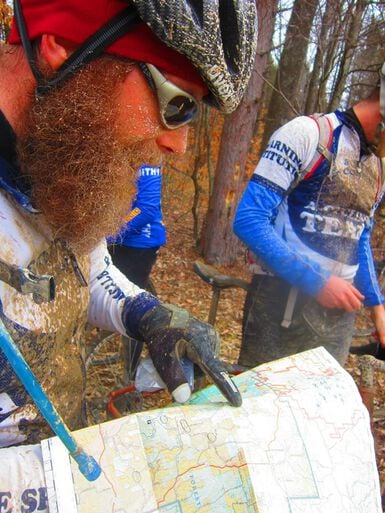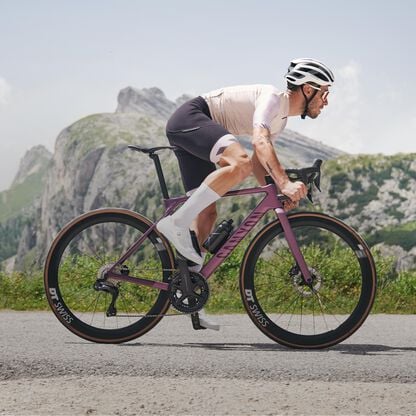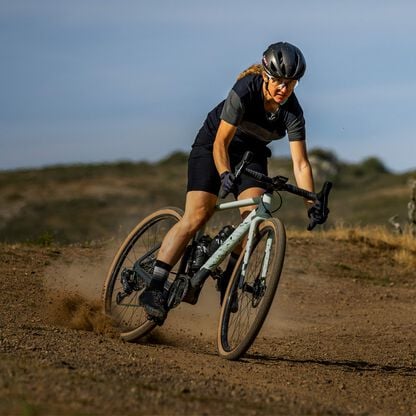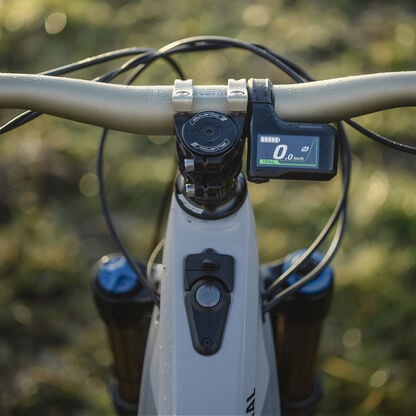Bike maintenance guide and checklist: How to service your bicycle yourself
Inspecting and maintaining your bicycle at regular intervals keeps it in top condition and prevents costly repairs. With our bike inspection checklist, you'll master the maintenance yourself—easily and step by step.


If you've mainly been pedalling on the indoor trainer over winter, your bike needs some tender loving care before it's ready for outdoor rides in spring. But even if you've been out on the odd winter ride, a thorough bike service is necessary. So should you head to the workshop? Not necessarily. Even as a beginner with no previous experience in bike maintenance, you can successfully tackle this task yourself. With our thorough bike maintenance checklist, you'll manage the servicing independently and gain a better understanding of your bike and how it works.
Contents
Why regular bike checks are so important
A well-maintained bike doesn't just ride better, it's also significantly safer: it runs quieter, shifts more precisely, and brakes more reliably. Regular inspections help you minimise wear on your bike and spot it early—before it becomes a safety risk or requires an expensive repair. Loose bolts, worn brake pads or a dirty, dry chain stand out immediately during a thorough check. What's more, components like tyres, cassettes, and chains last longer when you look after them. Overall, this saves you real money and avoids unpleasant surprises during your ride.
How often should you perform bike maintenance?
Give your bicycle a quick-check before every ride. A structured maintenance routine keeps your bike running smoothly and safely. Daily checks following the A-B-C-M principle—more on this below—take just 2–3 minutes and prevent most common issues.
Weekly and monthly inspections dig a bit deeper, covering components that don't need such frequent attention. You'll be checking things like shift cables, brake pads and spoke tension. Catching wear early means you can deal with it before it becomes a real problem.
For most riders, a weekly application of chain lube does the job. That being said, there's no one-size-fits-all service schedule for bicycles: how often you need to inspect your bike depends on how much you ride and the conditions you're riding in. During a heavy riding season, you should give your drivetrain a proper clean every few weeks. Regular bike cleaning means less maintenance down the line and fewer costly repairs or replacement parts in the long run. Cleaning your e-bike involves a few extra steps, so we've created a separate guide for that.
Your daily bike maintenance checklist
This checklist will help with your daily bike inspection or before every ride. Remember you’re A-B-Cs and the letter M. That's your guiding principle:
- A is for air: Make sure your tyres are pumped to the proper PSI and add air if needed.
- B is for brakes: Squeeze the brake levers to make sure your bike stops properly and reliably. Listen out for squealing or other odd noises and check your brake pads regularly for wear.
- C is for chain: Make sure the chain and sprockets are clean and well-lubricated, with everything running smoothly.
- The M-Check is a more thorough inspection of the bicycle, starting at the rear wheel. From there, you follow an M-shaped pattern along the bike: from the rear wheel up to the seatpost, down to the pedals and cranks, up to the handlebars and finally down to the front wheel. During this run-through, also check accessories on your bike: lights, reflectors, bell, and rack. Look out for loose or rattling parts and tighten any bolts and nuts you find are loose
Essential tools and tips for daily bike inspection
For a quick yet thorough inspection, you don't need much:
- A bike pump with a pressure gauge gives you precise tyre pressure readings.
- A set of hex keys lets you tighten any loose bolts on your handlebars, saddle, or stem.
- A clean rag makes it easier to spot dirt and check whether your chain needs lubrication.
Keep an eye out for cracks in your tyre sidewalls, worn brake pads, or frame damage. If you're riding long distances regularly, it's worth applying chain lube daily (and always wipe off the excess). This takes a bit more time but keeps your drivetrain running smoothly and quietly.
Pro tip: Work systematically through the A-B-C-M checks. Spin both wheels individually and listen for wobbling or rubbing sounds. Give the handlebars and saddle a gentle wiggle to identify any loose connections.

Your monthly bike maintenance checklist
You don't need to check all components fully before or after every ride. The following step-by-step guide shows you which parts to inspect on a weekly or monthly basis to ensure your bike stays in top condition.
Step 1: Clean and lubricate your drivetrain
A clean, properly lubricated drivetrain is the easiest way to keep your bike running smoothly and efficiently. To extend the time between thorough cleanings, many mechanics recommend wiping down your bike and chain after every ride. This extends the intervals between deep cleans.
You'll know it's high time for a thorough drivetrain clean when black gunk builds up on your chain and cassette. Ideally, you should get out the cleaning supplies before it reaches that point.
Fill a bucket with warm, soapy water and use drivetrain degreaser. Use a sponge and brushes to thoroughly remove dirt and lube residue. Make sure you clean each link of your chain and in-between the cassette sprockets. While you're at it, cleaning your pedals probably wouldn’t hurt either. Make sure your pedals and cleats aren't too worn and fit new cleats to your shoes if needed.
Once you’ve cleaned your drivetrain, dry it with clean rags. Now it's time to lube your chain. If you've got unlimited patience, you can slowly spin the chain and make sure every pin gets a tiny drop of lubricant. If you'd rather get back to riding quickly, rotate the pedals steadily whilst applying a stream of lube to the chain. Make sure you complete at least one full chain revolution. This method is faster but messier and uses more chain lube. Either way, make sure you use a clean rag to wipe off any excess lubricant afterwards.
The best tools and pro tips for cleaning and lubing your drivetrain
For a professional drivetrain clean, you'll need the right tools and supplies:
- a 5-litre bucket
- warm water
- biodegradable drivetrain degreaser
- several brushes in different sizes to reach awkward spots
- possibly, a chain cleaning device to simplify the process
- several clean rags for drying and wiping
The choice of chain lubricant depends on the conditions you're riding in:
- Dry lubes suit dry, dusty conditions and attract less dirt.
- Wet lubes last longer in rain and wet weather but tend to pick up more grime.
- Chain wax offers longer-lasting protection and better lubrication than oil-based products, but the hot wax application is more complicated.
- For regions with changeable conditions, an all-weather lubricant is often the best choice.
Always apply chain lube to the inside of the chain—where the pins sit. The outside doesn't need lubrication, as applying lube there just attracts dirt.
Let the lubricant sit for 10 minutes and turn the cranks a few times before wiping off the excess. This helps the lube penetrate deep into the chain links.
After particularly mucky rides—say, in the rain or on muddy trails—a quick wipe with a damp rag often does the job.
During an intensive riding season, give your drivetrain a thorough clean at the following intervals:
- Every 125–185 miles (or 200 - 300km) if you're riding a lot through rain or mud.
- Every 185–310 miles (or 200 - 300km) if you mostly ride in dry conditions and on tarmac roads
- Immediately if the chain crunches when shifting
For more tips, check out our guide on how to properly clean your chain.

Step 2: Check and adjust your tyre pressure
Whether you're riding a road bike, a hybrid bike, or a mountain bike, the perfect tyre pressure often comes down to personal preference—much like choosing chain lube. Every rider has their own sweet spot that gives them the best balance of comfort and speed.
High pressure lets you roll faster but can feel harsh and jarring on bumpy terrain. Lower pressure offers more contact area, better grip, and comfort—though it costs you speed and increases tyre wear. Experiment and find the right tyre pressure for you.
We've put together guidelines and helpful considerations for optimal tyre pressure on road bikes, mountain bikes, and gravel bikes.
Generally speaking, you should adjust tyre pressure to suit the riding conditions. In rain, ice, or snow, drop the pressure—the larger contact area gives you more stability and control. The same applies to rough terrain when mountain biking or gravel riding. More tyre contact means better grip and safer handling in challenging conditions.
Tools and tips for checking and adjusting tyre pressure
A track pump with an integrated pressure gauge is your most important tool for ensuring precise tyre pressure. Digital gauges display pressure with great accuracy, though analogue versions work perfectly well, too. During rides, you should carry a compact hand pump or CO₂ cartridges with a mini gauge.
Always check the maximum and minimum pressure stated on the tyre sidewall. Never exceed or go below these limits.
- Check tyre pressure before every ride if possible. Tyres lose air gradually, even without visible damage. Tubeless systems also experience significant pressure loss.
- Always measure pressure when tyres are cold—during a ride, the air warms up and pressure increases.
- Experiment with 3–7 PSI differences (0.2–0.5 bar) and pay attention to how the handling changes.
- Increase the pressure slightly for longer rides or when carrying luggage.
- If you're commuting by bike in the winter, you can drop pressure by 7–15 PSI (0.5–1 bar). This improves grip on slippery surfaces.
- You should also check your bike tyres regularly, meaning inspect them for wear and replace tyres in good time.
Step 3: Check and maintain your brakes
Your brakes are among the most safety-critical components on your bike and need regular attention. They must bring your bike to a reliable stop every time you ride.
When you pull the brake levers, you'll notice immediately if something's wrong. A spongy feel, excessively long lever travel, or squealing are all clear warning signs. Also listen for rubbing noises while you ride—if the rotor is scraping against the brake pad, the alignment is off.
Brake pads and rotors are subject to natural wear and tear. You must check them regularly and replace them when necessary. Replace the pads when they fall below the manufacturer's recommended minimum thickness or show significant wear. A new brake disc is due when you can feel a noticeable ridge on the rotor between the wear zone and the unused area. Hydraulic brakes occasionally need bleeding when the levers feel spongy.
Tools and tips for proper brake maintenance
You only need a few tools for a thorough brake inspection. A torch or your phone light helps you assess pad thickness without removing the wheels. If you do remove them, measure the remaining thickness precisely with a digital calliper or measuring gauge. Most pads should be replaced when less than 1.5mm of material remains—some manufacturers specify 2mm.
If your brakes squeal, you'll need brake cleaner or isopropyl alcohol (at least 90% concentration) and clean, lint-free rags. Never use regular cleaners. They leave residues on the pads, reduce braking performance, and can make squealing worse.
- Clean your brake rotors and pads regularly with isopropyl alcohol to remove oil and dirt residue. Even the smallest contamination drastically reduces braking power.
- After replacement, you must bed in new pads and rotors: perform 20–30 moderate braking actions from medium speed without coming to a complete stop.
- Check brake calliper alignment if the brake is rubbing. Loosen the mounting bolts slightly, pull the brake lever firmly, and slowly tighten the bolts again. This allows the calliper to self-centre.
- For mechanical disc brakes, adjust the pads using the adjustment screws on the brake calliper.

Step 4: Check the drivetrain
Check your drivetrain routinely during every bike inspection—and whenever the chain slips or shifting becomes less precise. You can spot worn sprockets and chainrings by their teeth: if they look like shark fins or show asymmetric wear, it's time for replacement.
How to change a bicycle cassette step by step:
- Remove the rear wheel and thru-axle.
- Attach the chain whip to prevent the cassette from rotating to the left.
- Insert the cassette tool and turn the lockring firmly to the left (anticlockwise).
- Lift the cassette carefully, holding it top and bottom—it consists of multiple parts.
- Clean the freehub and prepare the new cassette.
- Find the notches on the freehub and align the cassette grooves with them.
- Slide on the sprockets one by one—each part must fit exactly into the grooves.
- Tighten the lockring until you hear several clicking sounds.
You don't have to replace your cassette every time you fit a new chain, but every new cassette needs a new chain. As a rule of thumb: if you ride 3,000–5,000 miles (or 5,000–8,000km) annually, replace the cassette at least once per season and the chain twice.
Tools and expert tips for drivetrain inspection
Drivetrain care requires specialist bike maintenance tools:
- A chain whip holds the cassette in place while you loosen the lockring with the cassette tool (varies by manufacturer: Shimano, SRAM, or Campagnolo).
- A torque wrench helps you tighten the lockring correctly. If the ring is too tight, it damages the threads; too loose and the cassette has play and damages the freehub body.
- A chain checker tells you when to replace your chain. It measures chain elongation due to wear.
Wear criteria for different components:
- The chain is your number one wear component. It lasts 1,200–2,500 miles (2,000–4,000km), depending on model, maintenance, and conditions. Replace the chain in time (at 0.5–0.75% elongation). The cassette will last 2–3 chain changes.
- Cassettes show wear through rounded or shark-fin-shaped teeth. The frequently used, smaller sprockets wear faster than the larger ones. If the new chain skips over the teeth under load, it's high time for a new cassette.
- Chainrings wear more slowly but still need attention. If you notice asymmetrically worn or pointed teeth, it's time for a new chainring.
Pay attention to system compatibility: Shimano, SRAM, and Campagnolo components are not cross-compatible. The number of sprockets at the rear (11-speed, 12-speed, 13-speed) determines which chain and cassette you need.
Step 5: Check the bike frame and handlebars
Your frame is the heart of your bike and deserves regular attention. Check for cracks, dents, paint chips, or deformations—especially at high stress areas like weld seams, dropouts, and the bottom bracket area. On carbon frames, also look for dull spots, delamination, or hollow sounds when gently tapping. Even small damage can weaken the structure. Visit a bike workshop if you suspect frame damage.
Handlebars, stem, and grips or bar tape must sit firmly and securely. Don't shake them too aggressively during the bicycle inspection and only tighten mounting bolts to the specified torque. You'll usually find this value stamped in Newton metres (Nm) next to the thread hole. A torque wrench helps you tighten bolts precisely without damaging threads or overstressing components.
Inspect all connection points: headset, seat clamp, bottle cage threads, and derailleur hanger. Wiggle the handlebars and saddle gently to detect play. Creaking noises while riding often indicate loose bolts or damaged bearings. Investigate the cause immediately if you hear creaking or other unusual sounds while cycling.
Tools and expert tips for bike frame and handlebar inspection
A torque wrench is essential for modern bikes, especially those with carbon frames and components. There are two variants: Click-type torque wrenches (easier to use, clicks when reaching the pre-selected torque) and digital torque wrenches (continuously displays the current value). For bikes, you need a range of 2–25 Nm. Most bolts fall between 4 and 8 Nm.
Tighten bolts in a cross pattern (when there are multiple bolts). This distributes tension more evenly.
Apply torque gradually: first to 50%, then 75%, and finally 100% of the target value.
Check all critical bolts after every transport (car, plane)—vibrations can loosen them.
Inspect the frame thoroughly after crashes or hard impacts. Document damage with photos and have critical areas assessed by the Canyon Support Centre or a specialist workshop. Photos are important for warranty claims.
Step 6: Test-ride your bike after the inspection
After any bike maintenance that goes beyond simple chain lubing or tyre inflation, take a test ride. It's the only way to ensure everything works properly. Spend a few extra minutes now rather than facing problems halfway through your next big ride.
Choose a quiet street or empty car park for the test ride. Start slowly and gradually increase intensity. Pay attention to unusual noises, vibrations, or changed handling.
Checklist and tips for the test ride after bike maintenance
Test all functions on your bike systematically:
- Shift through all gears front and rear. The chain should move smoothly from sprocket to sprocket without delay. Also shift under load (a gentle climb or against the wind) to ensure the chain shifts cleanly.
- Brake from different speeds—gently at first, then firmly. Both brakes must slow you evenly without squealing or rubbing. The brake point should be clearly defined, not spongy.
- Ride out of the saddle and listen for creaking at the frame or bottom bracket. Test steering stability in tight turns.
- Ride over small bumps and test the steering. Play in the headset or loose bolts will become noticeable now.
- Let the bike coast and listen for rubbing noises or rattling.
A structured test ride takes 10–15 minutes. Work methodically: pull both brake levers, spin the wheels, and check that the handlebar sits securely.

Common problems and quick solutions during bike checks
Even with regular maintenance, problems occasionally crop up. Our troubleshooting guide helps you recognise typical issues and fix them quickly. By spotting issues or defects early and addressing them, you'll avoid canceled rides and reduce the chances of being stranded roadside with a broken bike.
The following solutions cover the three most common problems you'll encounter while cycling.
1. Flat tyre
A flat tyre is the most common problem you encounter when you ride your bike. Distinguish between slow leaks (gradual air loss over hours or days) and a sudden flat (immediate air loss from a puncture). Basic tyre repair is an essential skill for every cyclist:
- Find the hole: Inflate the tube and hold it to your ear, lips, or submerge it in water—air bubbles reveal the hole. Mark it with chalk or a pen.
- Patch or replace: You can patch small holes (under 3mm) reliably. For larger tears, porous tubes, or multiple holes, replacement is the best option. Patch kits save space during rides, but a new tube is quicker to install.
- Tyre inspection: Before reinstalling the tube, thoroughly inspect inside the tyre (the so-called red finger test). Embedded thorns, glass shards, or small stones will otherwise cause the next puncture immediately. Also check the rim for sharp edges, slipped rim tape, or protruding spoke nipples.
2. Noisy brakes
Brake noise is annoying and often indicates problems. The most common causes are glazed (overheated) or contaminated brake pads from oil, debris, or cleaning products.
- Squealing: These annoying sounds are usually caused by dirty or glazed pads. Clean the rotors and pads with isopropyl alcohol. For glazing, lightly sand the pad surface with fine sandpaper or replace the pads.
- Grinding and shuddering when braking: This indicates completely worn pads, meaning the metal backing plates are scraping the rotor. You need to replace the pads immediately, otherwise you'll damage the disc.
- Rubbing noises while riding: These sounds occur when a brake calliper isn't centred or the rotor is warped. Loosen the calliper mounting, pull the brake lever, and fix the calliper bolts slowly again. It will self-centre. You can carefully straighten a warped rotor with a specialist rotor truing tool or replace it.
3. Shifting problems
Shifting problems usually have simple causes. The most common culprits are stretched cables and misaligned or bent derailleurs. Cable tension and derailleur alignment directly affect shifting precision.
- Sluggish shifting: This indicates incorrect cable tension or resistance in the housing. Increase the tension by turning the barrel adjuster on the derailleur anticlockwise (half a turn). Clean and lube old cables or replace them if you see visible corrosion or broken strands.
- Chain skipping: The most likely cause is a worn chain or cassette. Check this with the chain checker tool. If the derailleur is misadjusted, this may also cause the chain to skip. You can use a specialist derailleur hanger alignment tool if the hanger is bent. Resetting the limit screws sometimes helps as well.
- Shifting doesn't work at all: The most common causes here are a broken shift cable or a severely twisted derailleur. Check the cable for damage. If the derailleur or hanger is bent, straighten it with specialist tools or replace it.
Bike maintenance is easy with this checklist
Does this sound like a lot of work? Don't worry: with a little practice and our bike inspection checklist, you'll master these basic maintenance tasks in no time. You'll not only get to know your Canyon better, you'll also save money that you can invest in races, new gear, or another bike.
Regular bike maintenance significantly extends the lifespan of your components and ensures safe, reliable riding. If you ride an e-bike, also check out our checklist for the e-bike season start—you'll find additional tips for electric drivetrains and e-bike battery care there.
For more complex problems or when you're short on time, our Canyon service locations will take professional care of your bike. The experts handle everything from inspection to complete overhaul.
Did this article help?
Thank you for your feedback
-
 About the author
About the authorRobert Annis
Robert Annis is an award-winning outdoor-travel journalist. As an experienced writer and sport enthusiast he writes content that is inspiring with focus on road biking. You might have read Robert's articles in Bicycling, National Geographic, Outside, Travel + Leisure, Inside Hook, AARP, Midwest Living, Sierra, Hemispheres, Departures, Lonely Planet, Afar, Los Angeles Times, Chicago Tribune, RV Magazine, and Hidden Compass.










